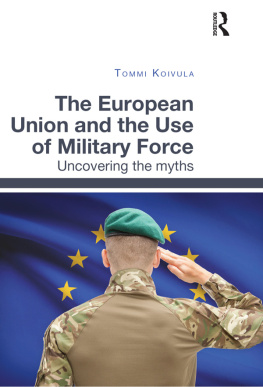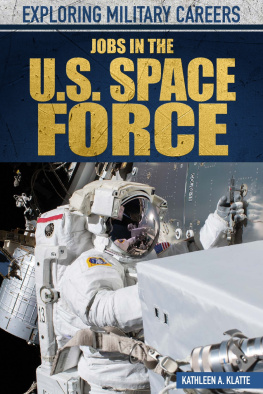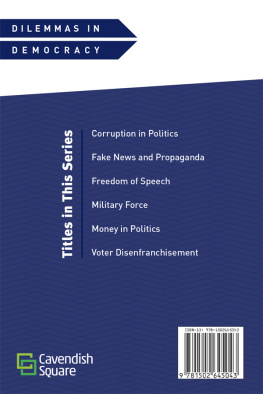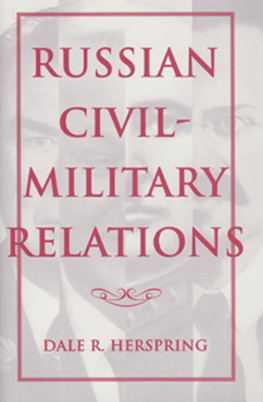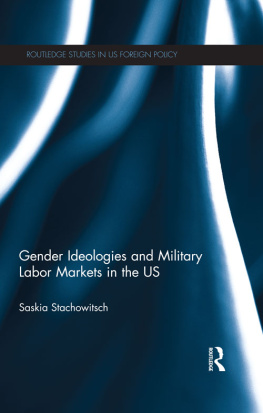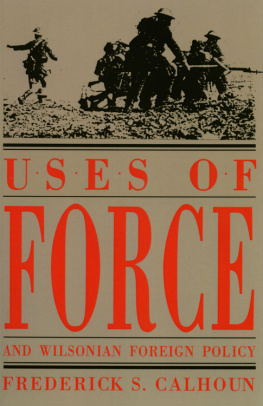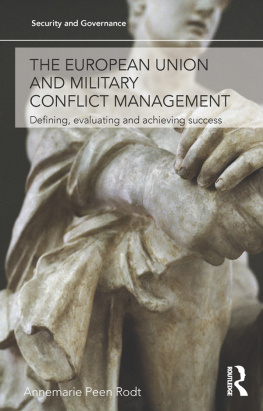The European Union and the Use of Military Force
Inventive in its approach and provocative in its analysis, this study offers a fresh reading of the European Union Common Security and Defence Policy (CSDP). In his examination of the discursive space related to the use of military force by the European Union, Tommi Koivula argues that even though the European Union uses military force extremely rarely, a discursive tension related to military force persists in the continuum of diverse perceptions of the Common Security and Defence Policy. The book offers a detailed study of the official high-level CSDP documents, a section devoted to dynamic accounts of CSDP operations and an analysis of the unofficial debate on EU military enforcement. By examining the EUs relationship to its military dimension during the course of its history, and by demonstrating that the contemporary CSDP discursive space is incoherent in nature and contains inherent contradictions, new insights will be given to the most sensitive question of whether extreme forms of military enforcement are appropriate for the EU.
Tommi Koivula is a Doctor of Social Sciences (University of Tampere, 2004) and works as a senior researcher at the Department of Warfare, the Finnish National Defence University. His current research areas include the security aspects of European integration and International Relations theory. Previously, he has been a lecturer at the University of Tampere, Finland, and a visiting researcher at the University of Kent at Canterbury, UK, in 2001.
First published 2016
by Routledge
2 Park Square, Milton Park, Abingdon, Oxon OX14 4RN
and by Routledge
711 Third Avenue, New York, NY 10017
Routledge is an imprint of the Taylor & Francis Group, an informa business
2016 Tommi Koivula
The right of Tommi Koivula to be identified as author of this work has been asserted by him in accordance with sections 77 and 78 of the Copyright, Designs and Patents Act 1988.
All rights reserved. No part of this book may be reprinted or reproduced or utilised in any form or by any electronic, mechanical, or other means, now known or hereafter invented, including photocopying and recording, or in any information storage or retrieval system, without permission in writing from the publishers.
Trademark notice: Product or corporate names may be trademarks or registered trademarks, and are used only for identification and explanation without intent to infringe.
British Library Cataloguing in Publication Data
A catalogue record for this book is available from the British Library
Library of Congress Cataloging-in-Publication Data
A catalog record for this book has been requested
ISBN: 978-1-4724-6805-5 (hbk)
ISBN: 978-1-3156-1646-9 (ebk)
Typeset in Times New Roman
by Apex CoVantage, LLC
Like many people who follow the European Union Common Security and Defence Policy, I have found it to be a source of both inspiration and frustration, of amazement and bewilderment.
In particular, its military dimension seems to be fraught with curious internal tension, even contradiction. Even though the European Union uses military force extremely rarely thus far only in a few crisis management operations it nevertheless seems to be haunted by its relationship to the physical use of military force. Indeed, the question of the EU using or not using military force seems to be at the core of most perceptions of the Unions role in international security: while in some quarters, the EU is seen as incomplete or insufficient because it is not particularly capable of military enforcement, others perceive it as a forerunner of new security thinking due to its renunciation of the traditional concepts of military power.
This book will argue that a discursive tension related to military force persists in the continuum of diverse perceptions of the Common Security and Defence Policy. This tension will be studied both in the official documents in which the EU defines itself and discusses its role in international security as well as in selected unofficial texts. Many books have been written on the CSDP and on the question of why military force has such a problematic and contested role within it. Yet the existing literature does not provide us with an empirical study of the discursive space focusing on the use of military force by the European Union. This is the subject matter this book will seek to tackle.
Therefore, this volume mostly leaves aside questions related to the institutional structure, functioning and history of the CSDP, as the existing literature provides plenty of excellent reviews and studies on them. Instead, myths, discursive conventions, silences, ambiguities and deeper undercurrents regarding the use of EU military power constitute the focus of this volume. Accordingly, the idea is not so much to explain the fundamental nature of the EUs CSDP but to ask new questions and to extend the way we can examine this evolving field of European policy.
A work as large as a book does not come about solely due to the efforts of its author. It should thus be noted that I am deeply grateful to a number of colleagues and students, many of whom cannot be mentioned separately for providing advice, support, critique and inspiration. Therefore, I would like to express my deepest thanks for my superiors Colonel Erik Erroll, Lieutenant Colonel, Dr.Soc.Sc Torsti Sirn and Colonel, Ph.D. Petteri Jouko for their support and understanding during the laborious writing process of this volume at the Finnish National Defence University. In addition, scholars such as Mika Aaltola, Pami Aalto, Mika Kerttunen, Arto Nokkala, Hanna Ojanen, Jyri Raitasalo, Tommi Sikanen, Joonas Sipil, Pekka Sivonen, Mikko Tyrvinen and Tarja Vyrynen, among other colleagues, have stimulated me with their intellect and insights. During the publishing process, I received most valuble advice and support from an anonymous reviewer, Brenda Sharp and Kirstin Howgate. Sheri Sipka and the editorial team at Apex CoVantage provided crucial help in preparing the book for the printer. Special thanks should go to Laura Murto for her outstanding efforts in correcting my English and commenting on the manuscript. Thank you all!
The Finnish Foundation for the Support of Strategic Research, the Mannerheim Foundation, Pivi Hetemki Foundation and the Research Fund for Military Sciences have kindly supported this effort with scholarships and grants.
A different kind of support equally vital to the writing process was given by people close to me. Here, I would like to thank in particular my parents Urpo and Ritva and my mother-in-law Aulikki, who all have been there to support and encourage me. I owe my greatest thanks, however, to my family Kirsi, Leevi and Saana who have endured with me during the good and the not-so-good days.
Helsinki, September 2015

